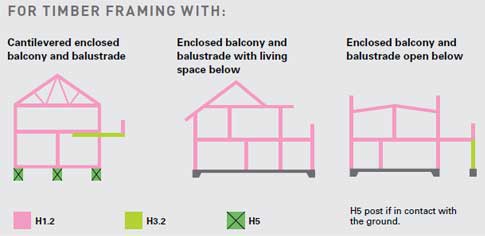A new timber treatment system for Acceptable Solution B2/AS1
- tough against fungal decay and insect attack
- simpler and easier to use
- protects framing from decay
- time and cost effective.
Timber treatment in Acceptable Solution B2/AS1 has changed to a new, simpler system:
If you are using the Acceptable Solution to demonstrate compliance with the Building Code, H1.2 is now required for nearly all radiata pine and Douglas fir enclosed timber framing.

What's new with timber treatment?
The Acceptable Solution B2/AS1 has changed. The timber treatment hazard class H1.2 is now required for radiata pine and Douglas fir timber in buildings, where it is protected from the weather (such as, enclosed timber framing). Consult the tables in this booklet for the few exceptions to H1.2 treatment.
Why H1.2?
Research shows that H1.2 gives framing timber good protection from decay. H1.2 boron treatment is colour-coded pink.
How can I be sure my timber framing complies with the Building Code?
The changes in this booklet outline one way to comply with the New Zealand Building Code durability clause B2. However, the booklet is only a quick guide, so consult Acceptable Solution B2/AS1 for full details.
Why continue to treat timber?
Timber must be adequately protected against damage from fungal and insect attack so that buildings are durable and comply with the Building Code. The new system improves the overall level of protection against decay.
What about other species of wood for framing?
For other species of wood and engineered wood products (such as LVL and Glulam), the Acceptable Solution does not change. For information on other species which can be used under the Acceptable Solution, consult NZS 3602:2003 Tables 1 and 2.